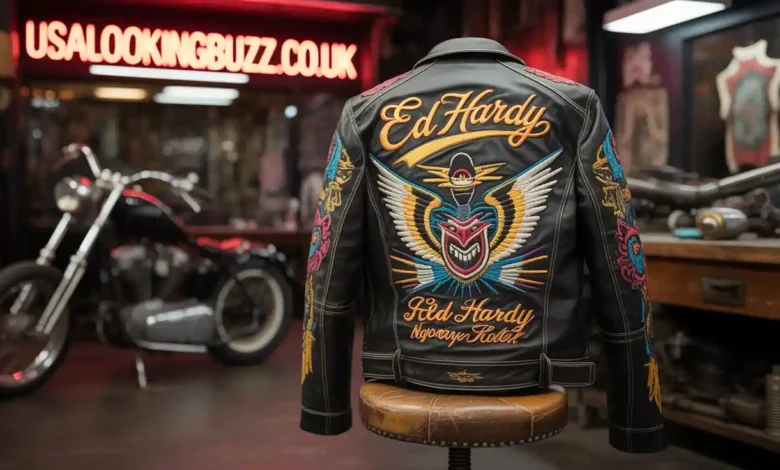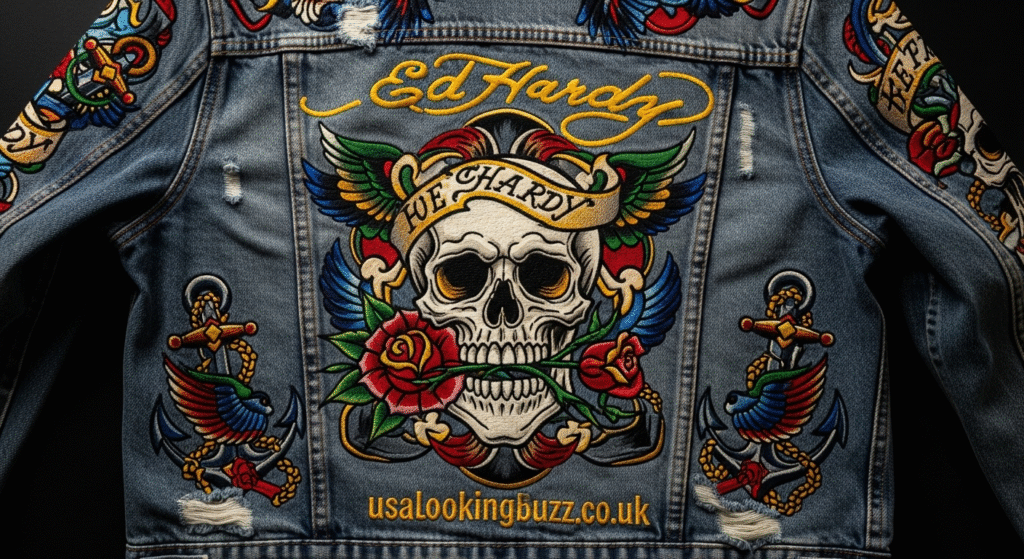Ed Hardy: The Bold Rise and Fall of Fashion’s Wildest Brand

Introduction
Remember walking into a mall in 2007 and seeing Ed Hardy everywhere? The bold graphics, the rhinestones, the tiger designs screaming from every hoodie and t-shirt. Ed Hardy wasn’t just a fashion brand. It was a cultural moment that defined an entire era.
The Ed Hardy story is fascinating because it shows how quickly fashion can rise and fall. One year, celebrities wore it on red carpets. The next, it became a punchline. But there’s more to this brand than its controversial reputation suggests.
Understanding Ed Hardy means learning about tattoo culture, licensing deals, and how branding can make or break an empire. You’ll discover why the brand exploded in popularity, what caused its dramatic decline, and whether it has a future. This article takes you through the complete journey of one of fashion’s most polarizing brands. Whether you loved it or hated it, the Ed Hardy phenomenon left an undeniable mark on early 2000s culture.
The Artist Behind the Brand
Don Ed Hardy: Tattoo Pioneer
Before Ed Hardy became a fashion label, it was the name of a legendary tattoo artist. Don Ed Hardy revolutionized American tattooing. He studied under Sailor Jerry Collins, one of the most influential tattoo artists in history.
Hardy brought fine art sensibility to tattooing. He studied printmaking at the San Francisco Art Institute. This background helped him elevate tattoo art beyond sailors and bikers. He created intricate designs mixing American traditional with Japanese techniques.
His tattoo work appeared in galleries and museums. Prestigious institutions recognized him as a serious artist. He published books about tattoo history and culture. His contributions to tattooing cannot be overstated.
In the 1970s and 1980s, Hardy’s San Francisco tattoo shop became legendary. Celebrities and art collectors sought his work. He transformed tattooing into a respected art form. His designs featured bold lines, vibrant colors, and intricate details.
From Skin to Fabric
Don Ed Hardy never intended to become a fashion brand. In 2004, French designer Christian Audigier approached him with a licensing deal. Audigier wanted to put Hardy’s tattoo designs on clothing.
Hardy agreed to license his artwork and name. He trusted Audigier’s vision for bringing tattoo culture to mainstream fashion. This decision would change everything. Within a few years, Ed Hardy clothing appeared everywhere.
The licensing arrangement meant Hardy received royalties but had limited creative control. Audigier drove the brand’s direction and marketing. This distinction becomes important when understanding what happened later.
Hardy’s original artwork was thoughtful and artistic. The fashion interpretations became something different. Rhinestones, metallic prints, and bold text transformed his subtle designs into loud statements. The fashion world’s Ed Hardy bore little resemblance to the artist’s original vision.
The Explosive Rise of Ed Hardy Fashion
Christian Audigier’s Marketing Genius
Christian Audigier understood celebrity culture. He previously worked with Von Dutch, another brand that achieved rapid fame. His strategy was simple: get celebrities wearing the clothes, and everyone else would follow.
Audigier sent free Ed Hardy pieces to every celebrity he could reach. The strategy worked brilliantly. Madonna, Britney Spears, and Paris Hilton started wearing the brand. Paparazzi photos spread the designs everywhere.
The timing was perfect. The mid-2000s obsessed over celebrity culture. Reality TV was exploding. TMZ documented every celebrity outfit. Ed Hardy rode this wave expertly. When Jon Gosselin from “Jon & Kate Plus 8” wore it constantly, the brand reached peak visibility.
Audigier also understood aspirational marketing. The clothes weren’t cheap. T-shirts cost $70 to $100. Hoodies reached $200 or more. This pricing made people feel they were buying into exclusive celebrity lifestyle.
The Distinctive Ed Hardy Aesthetic
You could spot Ed Hardy from across a room. The designs were intentionally loud and unmistakable. Tigers, koi fish, skulls, roses, and eagles covered every surface. Rhinestones added sparkle. Metallic prints caught the light.
Text was everywhere. “Love Kills Slowly” became a signature phrase. Other slogans appeared across shirts, jeans, and accessories. The typography mixed gothic and graffiti influences. Every piece made a statement.
The color palette was bold. Bright colors mixed with black. Neon accents drew attention. Nothing about Ed Hardy was subtle. That was the point. Wearing it meant you wanted to be noticed.
The brand expanded beyond clothing. Hats, belts, shoes, sunglasses, and even energy drinks carried the Ed Hardy name. Perfumes and accessories flooded department stores. At its peak, you could cover yourself head to toe in the brand.
Peak Popularity and Sales Success
Between 2004 and 2009, Ed Hardy generated hundreds of millions in revenue. Department stores created dedicated sections. Bloomingdale’s and Nordstrom featured prominent displays. The brand seemed unstoppable.
Licensing deals multiplied the reach. Companies produced Ed Hardy versions of almost everything. Phone cases, luggage, and home goods appeared. The brand’s omnipresence became both its strength and eventual weakness.
Young people especially embraced the aesthetic. Shopping malls became Ed Hardy fashion shows. Groups of teens wore matching pieces. The designs symbolized rebellion and edginess to a generation too young for actual tattoos.
International markets loved it too. Asia and Europe embraced the bold American aesthetic. Ed Hardy stores opened in major cities worldwide. The global expansion seemed to validate the brand’s staying power.
The Dramatic Fall from Grace
Oversaturation and Overexposure
Ed Hardy’s success contained the seeds of its downfall. The brand appeared everywhere simultaneously. When you see the same designs in every store and on every person, exclusivity disappears.
Knockoffs flooded markets. Cheap imitations appeared at flea markets and discount stores. The line between authentic and fake blurred. The brand’s value perception plummeted when anyone could buy a similar looking shirt for $10.
Department stores marked down inventory aggressively. Seeing Ed Hardy on clearance racks damaged its premium image. What once cost $100 now sold for $20. This discount culture destroyed the aspirational appeal.
Celebrity associations that helped the rise accelerated the fall. When certain celebrities wore something too much, public opinion turned. Jon Gosselin’s constant Ed Hardy appearances during his messy divorce made the brand seem tacky rather than cool.
Cultural Backlash and Ridicule
Fashion critics never loved Ed Hardy. As mainstream popularity grew, criticism intensified. The designs were called gaudy, trashy, and tasteless. Fashion publications mocked the aesthetic relentlessly.
Social media amplified the backlash. Memes comparing Ed Hardy to fashion disasters went viral. Wearing the brand became socially risky. Young people who embraced it earlier now felt embarrassed.
The association with specific demographics hurt too. Ed Hardy became linked with “douchebag” culture. This unfair but persistent stereotype made the brand toxic. People avoided it to distance themselves from negative connotations.
Tattoo purists criticized how the brand commercialized tattoo culture. What Don Ed Hardy created as art became mass-produced mall fashion. The disconnect between authentic tattoo culture and commercial exploitation bothered many people.
Don Ed Hardy Distances Himself
As the brand’s reputation suffered, Don Ed Hardy spoke publicly about his regrets. He expressed disappointment with how his art was used. The licensing deal that seemed brilliant earlier now felt like a mistake.
Hardy gave interviews clarifying his limited involvement. He wanted people to know the fashion brand didn’t represent his artistic vision. This distinction mattered to him personally and professionally.
He couldn’t stop the brand from using his name and designs. The licensing agreement remained valid. But he could distance himself publicly. His statements highlighted the danger of licensing your name without creative control.
The artist continued his fine art career separately. He held gallery exhibitions and published books. His reputation in the art world remained intact. The fashion controversy existed in a different sphere.
Ed Hardy in the 2010s and Beyond
Attempts at Reinvention
After hitting rock bottom around 2010, Ed Hardy attempted several comebacks. New designers tried refreshing the aesthetic. The goal was keeping brand recognition while shedding negative associations.
Some attempts toned down the designs. Subtler graphics and fewer rhinestones appeared in new collections. These changes aimed at attracting customers who wanted something less loud.
The brand also targeted international markets more aggressively. Asian markets remained relatively strong. Countries where the brand had less cultural baggage showed more potential. This geographic strategy helped sustain some revenue.
Online retail became important. Rather than relying on department stores, Ed Hardy developed direct-to-consumer channels. This approach provided better control over presentation and pricing.
Current Status and Availability

Today, Ed Hardy exists but operates much smaller than its peak. You can still buy the brand online and in select stores. The product line continues but with significantly reduced visibility.
Certain items maintain nostalgic appeal. People who loved Ed Hardy during its heyday sometimes buy pieces for sentimental reasons. Vintage or original pieces from the peak era have some collector interest.
The brand occasionally collaborates with other companies. Limited edition releases generate brief attention. These strategic partnerships help maintain relevance without committing to full-scale production.
Physical retail presence has shrunk dramatically. Major department stores no longer feature dedicated Ed Hardy sections. The brand exists primarily in the discount and online spaces now.
The Cultural Impact and Legacy
What Ed Hardy Taught the Fashion Industry
The Ed Hardy story provides valuable lessons about branding. Rapid expansion can destroy what made a brand special. Maintaining exclusivity matters more than maximizing short-term revenue.
Celebrity endorsement strategies need careful management. What celebrities wear can make or break a brand overnight. The relationship between celebrity culture and fashion is powerful but unpredictable.
Licensing deals require protecting creative vision. Don Ed Hardy’s experience shows the risk of licensing your name. Financial gain means nothing if the end product damages your reputation.
Authenticity cannot be manufactured. Ed Hardy fashion tried capturing tattoo culture’s edginess. But it became a costume rather than genuine expression. Consumers eventually recognize and reject inauthenticity.
Nostalgia and the Y2K Fashion Revival
Interestingly, early 2000s fashion is experiencing revival. Gen Z discovers and ironically embraces Y2K aesthetics. This trend includes elements once considered tacky.
Ed Hardy occasionally appears in this nostalgia wave. Young people wear it ironically or appreciate it as vintage. The context has changed completely. What embarrassed millennials in 2010 seems cool to a new generation.
This revival remains limited and ironic. Ed Hardy hasn’t returned to mainstream acceptance. But the complete rejection is softening. Fashion’s cyclical nature means nothing stays dead forever.
Some fashion historians now analyze Ed Hardy more generously. Time provides perspective. The brand captured a specific cultural moment. That historical significance matters regardless of quality judgments.
Comparing Ed Hardy to Similar Fashion Phenomena
Von Dutch and Trucker Hat Culture
Christian Audigier’s previous success with Von Dutch parallels Ed Hardy closely. Von Dutch trucker hats exploded in popularity around 2003. Celebrities made them ubiquitous.
Like Ed Hardy, Von Dutch rose fast and fell hard. Oversaturation killed the brand’s cool factor. The pattern repeated exactly. Both brands showed how quickly celebrity-driven fashion burns out.
The difference is Von Dutch focused primarily on hats and accessories. Ed Hardy attempted a complete lifestyle brand. This broader ambition meant more products but also more ways to overextend.
Affliction and Tapout: MMA Fashion
During Ed Hardy’s peak, similar brands emerged. Affliction and Tapout targeted the mixed martial arts audience. They used bold graphics, distressed fabrics, and aggressive designs.
These brands avoided some of Ed Hardy’s pitfalls. They maintained tighter focus on specific demographics. MMA fans provided a loyal base less influenced by mainstream fashion criticism.
However, they still faced challenges. The aesthetic dated itself. When MMA’s cultural moment passed, the fashion followed. These brands exist today but with reduced prominence.
Should You Wear Ed Hardy Today?
Considering Your Personal Style
Fashion is personal. If you genuinely love Ed Hardy designs, wear them confidently. Caring too much about others’ opinions limits self-expression.
That said, understand the social context. Ed Hardy carries baggage. People will make assumptions. You need to decide if you’re comfortable with those associations.
The ironic nostalgia approach works for some people. Wearing Ed Hardy as a statement about Y2K fashion can be fun. This requires a certain self-awareness and humor.
Vintage pieces from the brand’s peak have more cachet. Original items from 2006-2008 feel more authentic than current production. Collectors appreciate these as time capsules.
Styling Tips If You Choose to Wear It
If you wear Ed Hardy, balance is crucial. Don’t wear multiple branded pieces together. One item makes a statement. Head to toe coverage looks costume-like.
Pair Ed Hardy with neutral basics. A graphic tee works with plain jeans. A hoodie pairs with simple sneakers. Let the branded piece be the focus.
Choose designs carefully. Subtler graphics age better than heavily embellished pieces. Items without obvious branding or text feel less dated.
Consider the setting. Ed Hardy at a nightclub differs from Ed Hardy at the office. Context matters significantly for this brand.
The Business Side of Ed Hardy
Licensing and Intellectual Property
The Ed Hardy business model relied heavily on licensing. Multiple companies produced different product categories. This approach maximized reach but diluted brand control.
Licensing fees provided steady revenue with minimal overhead. Don Ed Hardy earned royalties without managing production or retail. This arrangement benefits rights holders financially.
However, quality control becomes challenging. Different manufacturers produce varying quality. Inconsistency damages brand perception. Ed Hardy suffered from this issue significantly.
The intellectual property itself remains valuable. Don Ed Hardy’s original artwork has worth beyond fashion. Future opportunities might leverage the art differently.
Manufacturing and Distribution
Ed Hardy production happened globally. Factories in Asia produced most items. This offshore manufacturing kept costs manageable despite retail prices.
Distribution channels varied widely. Department stores, specialty retailers, and eventually discount outlets all carried the brand. This diverse distribution contributed to overexposure problems.
The profit margins were substantial at peak. High retail prices with moderate production costs meant healthy profits. These margins attracted many licensees and retailers.
As the brand declined, maintaining distribution became difficult. Retailers reduced orders. Shelf space shrank. The distribution network that enabled rapid growth collapsed quickly.
Conclusion
The Ed Hardy phenomenon represents a unique moment in fashion history. From legitimate tattoo art to mall culture sensation to cautionary tale, the brand experienced everything. Its rise showed the power of celebrity marketing and bold design. Its fall demonstrated the dangers of oversaturation and cultural backlash.
Don Ed Hardy created beautiful tattoo art. Christian Audigier built a fashion empire. The disconnect between these two visions ultimately defined the brand’s trajectory. Today, Ed Hardy exists in a strange space between irrelevance and nostalgic curiosity.
Whether the brand achieves meaningful comeback remains uncertain. Fashion cycles could eventually bring full rehabilitation. Or Ed Hardy might remain a relic of the 2000s, studied but not worn. Either way, its impact on fashion, celebrity culture, and branding provides lessons that extend far beyond clothing.
What’s your Ed Hardy story? Did you love it, hate it, or watch from the sidelines? Do you think the brand deserves a second chance, or should some fashion moments stay in the past? The conversation about Ed Hardy continues because it touched something in our culture, for better or worse.
Frequently Asked Questions
Who created Ed Hardy clothing?
Christian Audigier created Ed Hardy clothing by licensing the name and artwork from tattoo artist Don Ed Hardy. Audigier previously worked with Von Dutch and applied similar celebrity-driven marketing strategies to launch the fashion brand in 2004. Don Ed Hardy provided the artistic designs but had limited involvement in the fashion brand’s direction.
Why did Ed Hardy go out of style?
Ed Hardy declined due to oversaturation, overexposure, and cultural backlash. The brand appeared everywhere simultaneously, losing its exclusive appeal. Negative associations with certain celebrities and “douchebag culture” damaged its reputation. Aggressive discounting at retail stores further destroyed the brand’s premium image. Fashion critics also relentlessly mocked the aesthetic.
Is Ed Hardy considered tacky now?
Most people consider Ed Hardy tacky today, though opinions are slowly changing with Y2K fashion nostalgia. During its peak decline around 2010-2015, wearing the brand was widely mocked. Younger generations now view it with ironic appreciation or vintage curiosity. The perception depends heavily on age, context, and how pieces are styled.
How much did Ed Hardy clothes cost originally?
Ed Hardy clothing was premium priced during its peak. T-shirts typically cost between $70 and $100. Hoodies ranged from $150 to $250. Jeans cost $200 or more. These high prices positioned the brand as aspirational and exclusive. However, aggressive discounting later made pieces available for as little as $20.
Does Don Ed Hardy still design clothes?
No, Don Ed Hardy does not design current clothing. He licensed his name and artwork to the fashion brand but maintains distance from the commercial products. He continues working as a fine artist, holding gallery exhibitions and publishing books about tattoo culture. He has publicly expressed disappointment with how his art was commercialized.
Where can you buy Ed Hardy now?
Ed Hardy is available through the brand’s official website, online retailers like Amazon, and select discount stores. The brand no longer has significant presence in major department stores. Some international markets, particularly in Asia, still carry Ed Hardy in specialty boutiques. Vintage pieces occasionally appear on resale platforms like eBay and Poshmark.
What made Ed Hardy so popular in the 2000s?
Celebrity endorsements drove Ed Hardy’s popularity. Stars like Madonna, Britney Spears, and Paris Hilton wore the brand, generating massive media exposure. The bold, distinctive designs stood out visually. Premium pricing created aspirational appeal. The timing coincided with peak celebrity culture obsession and reality TV explosion, making it the perfect cultural moment.
Is Ed Hardy coming back in style?
Ed Hardy is experiencing limited revival through Y2K fashion nostalgia, but not a full mainstream comeback. Younger consumers wear it ironically or as vintage fashion. The brand attempts reinvention with updated designs and limited collaborations. However, it hasn’t regained the cultural prominence it held during its peak years.
What’s the difference between Ed Hardy the artist and the brand?
Don Ed Hardy is a respected tattoo artist and fine artist who created the original designs. The Ed Hardy fashion brand licensed his name and artwork but operated independently under Christian Audigier’s direction. The artist had minimal creative control over how designs were used commercially. This distinction matters when discussing the brand’s controversial reputation.
Why are there so many fake Ed Hardy products?
Ed Hardy’s peak popularity made it attractive for counterfeiters. The bold, recognizable designs were easy to copy. High retail prices created profitable opportunities for knockoffs. Consumers wanting the look without the cost bought fakes. The prevalence of counterfeits further damaged the brand’s image and value perception.




